Egypt (part 1)
One of the biggest connoisseurs of philately from the region Sudan and Egypt was Peter A.S. Smith, who passed away in 2014. He collected, exposed and wrote several philatleic books about this region, and was generally renowned for his knowledge. As things go, his collection has been sold 1 year after his decease at the Swiss auctioneering firm Corinphila.
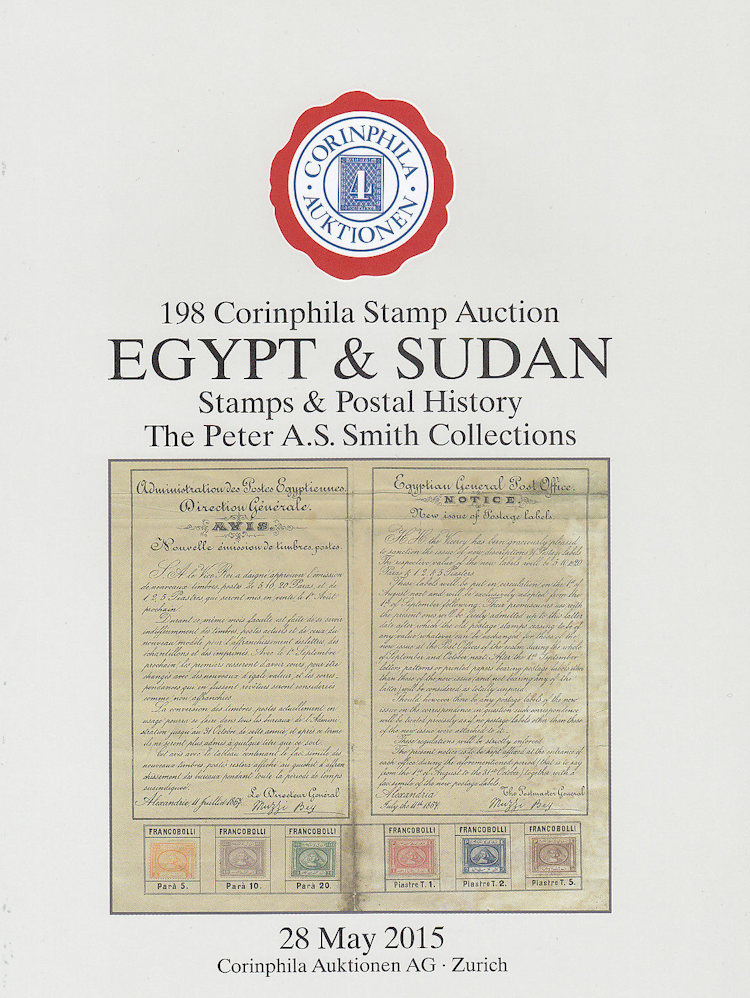
For us an opportunity to see a few pearls from the Smith collection. Off course especially the express stamps are interesting for us.
In 1922 the Egyptian Post started express services in Cairo and Alexandria, as well as between these two cities. The normal rate for a letter was in these days 5 Mills, and the extra costs for express delivery were 15 Mills.
A Mill is 1/1000th of an Egyptian Pound. Later 10 Mills became 1 Piaster (100 P = 1
E£).
Halfway the 1920-ies
the Egyptian king of that time commissioned to design an express stamp for his country. The designer prepared 3 essays (tests): two with the image of king Fouad, as is also found on the normal stamps of the country, but differing in lay-out, an one that is interesting for us, with a carrier walking towards 2 motorcycles, in the value of 15 Mills.
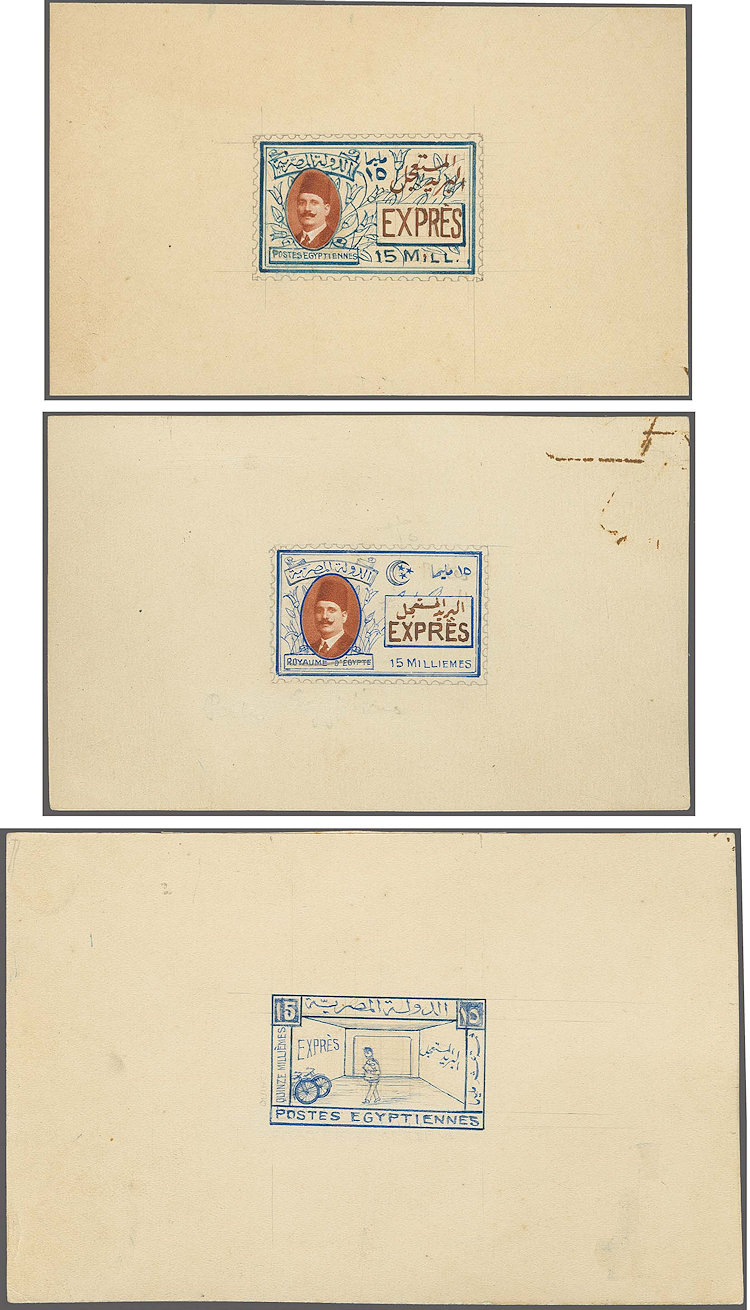

The tests have been drawn on hand-made paper on postcard format. The value on the designs was 15 Mills, with the intention to stick these as extra on postal items to pay for the extra service, as was done in other countries. According to the books of Smith only 3 essays from this time have remained.
The 3 together have been put in the auction of May 28th 2015 for a starting price of € 1.000,-, and finally
realized not less than € 25.000,-.
We know that these designs
were in the end not chosen, because the green version of the total amount to be paid of 20 Mills was selected. The postmasters thought it was too much work to stick an extra registration on the post, and somewhat later an extra label was put on.
On this stamp
we see a postman complete with crash-fez on presumably a Triumph model P of just less than 500cc. The postal services purchased 2 of these motorcycles for the enormous price of GB£ 30,- each.
In the banner above the
image is the text "Kingdom of Egypt" in general Arabic, and on the right "Express" in decorative writing. The express stamp was introduced on November 28th 1926.

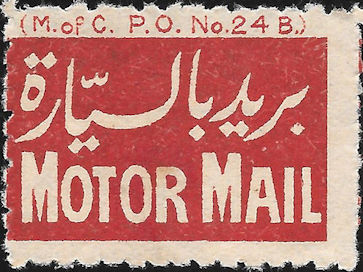
In 1929 the text was slightly changed into Egyptian Arabic and the stamp got a bi-colour appearance in the colours red and gray.
It lasted until 1940 before the tariff was changed: 6 Mills for the post and 19 Mills for the express service. Thus a total of 25 Mills. It was ordered to design a new express stamp. Also from these designs 3 have been offered for sale at Corinphila.
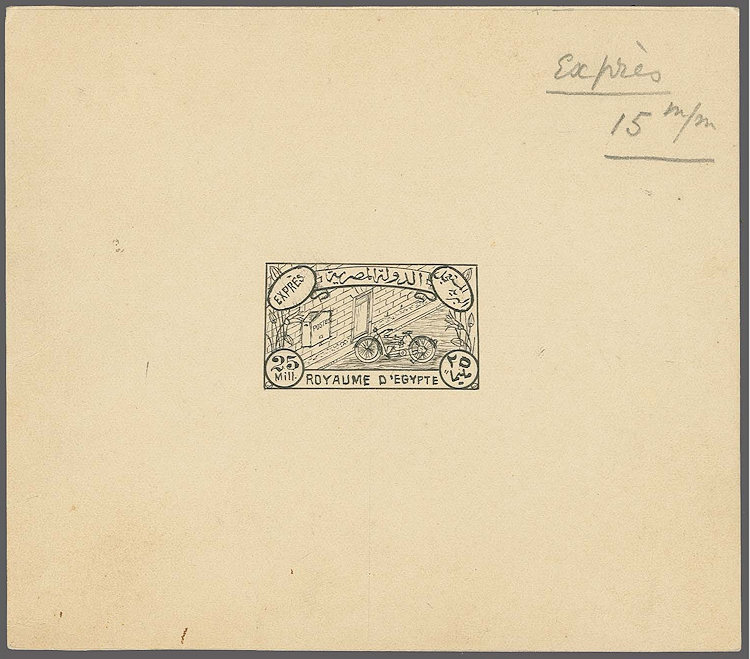

On the essay above the door and the motorcycle are recognisable from the American Special Delivery stamp but in a slightly different set-up. Small mistake was that for Express post the letter had to be handed over to the addressee, while this stamp gives the impression that it will end in the letterbox at the wall. The seconds design has almost the same image, only the stones in the wall are not visible now. The texts are of a completely different lay-out. The third design shows the carrier on his motorcycle. Also here the Arabic text is displayed "hanging", what severely decreases the image space.
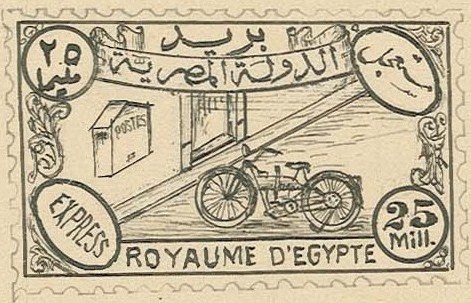

Also these 3 essays have been listed as 1 lot by Corinphila for € 3.000,- and have been sold for € 13.500,-.
Finally it was chosen to maintain the existing stamp image in modified colours. In due time the price for express delivery had increased with 1 Mills and in 1943 (March 1st) a stamp of 26 Mills was put into use. Less than half a year later (May 1943) the price for express delivery had increased to 30 Mills and the letter tariff to 10 Mills. This made that on November 18th 1944 a new stamp was put into use of 40 Mills with again changed colours. Now brown with black image.
After the withdrawal of the British from the trust territory Palestine (May 15th 1948) Egypt would take charge of part of Palestine. For postal purposes Egyptian stamps were imprinted with the text "Palestine" in Arabic and Latin writing. The earliest known envelop were the Palestine imprint was used has been stamped on June 11th 1948 in Bethlehem. But the war of independence of the Jewish state soon made an end to the Egyptian control.
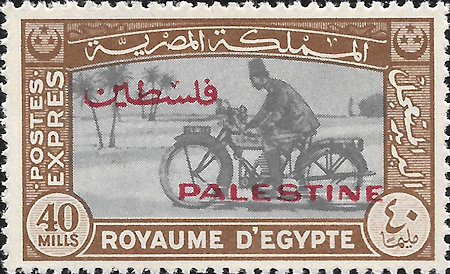
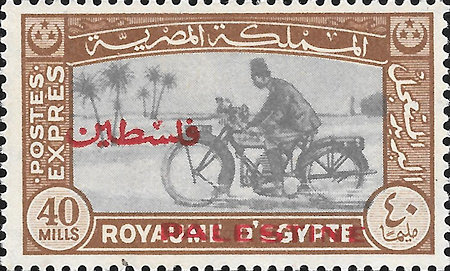
There are variants with the imprint at another height on the stamp
This defeat made that the popularity of King Farouk declined, and to emphasize his leadership over the Arabs, stamps and other items were overprinted with the text in normal arabic: Farouk King of Egypt and Sudan, 16 October 1951.

First the imprint was made in different colours as a test. The tested colours are blue, red, green, brown and black, the last one has finally been used.

The 5 different tested colours
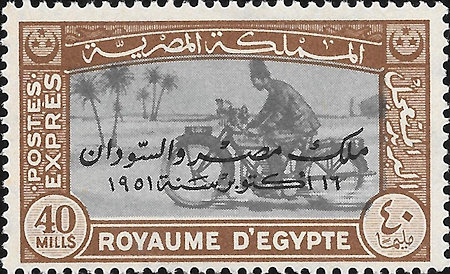
The finally issued stamp with black imprint
The stamp appeared on January 17th 1952, and on July 23rd 1952 the king was deposed after a coup by Colonel Nasser.
But King Farouk has made a nice series of "monsters" for us. As enthusiast philatelist (just like his father), he let make misprints and misperforations specially for his collection. Of each sheet issued during the reign of King Farouk 2 sheets of 50 stamps were made in this way.
Here a few of examples of such stamps that are nice for us.
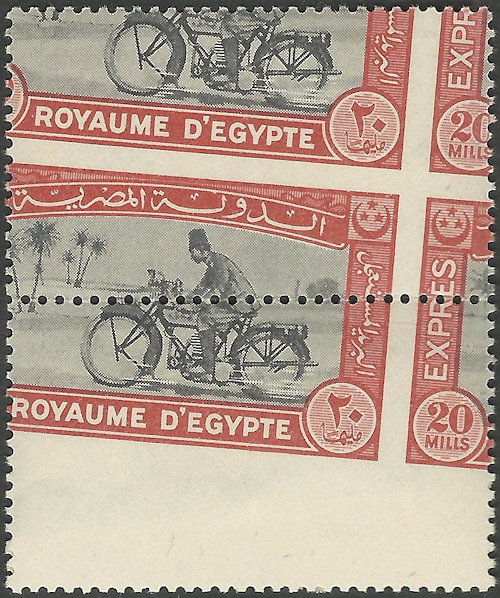
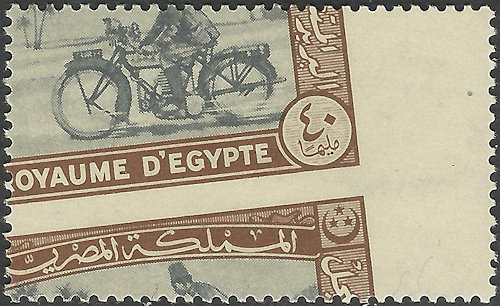

It is almost sure that our friend Peter A.S. Smith has acquired quite some items from this collection when, after the resignation of Farouk, his philatelic belongings were sold by auction at Gimbels in Milwaukee.
Most information in this article comes from the auction catalog from Corinphila and from the books of collector Smith.
More Egypt in part 2.
Hans de Kloet
Top - Back to former page - Home |
















